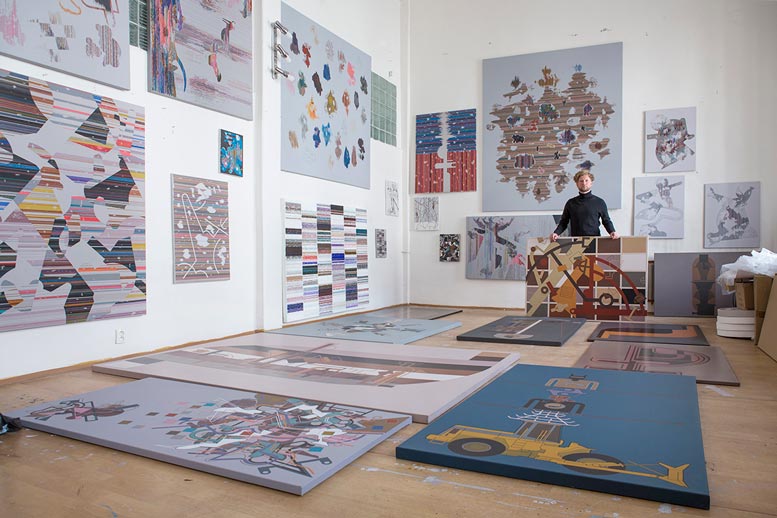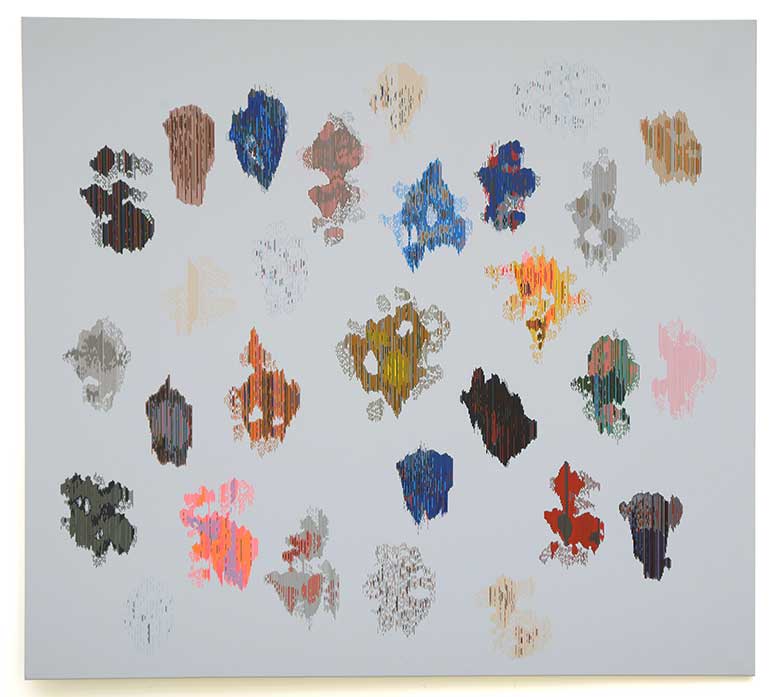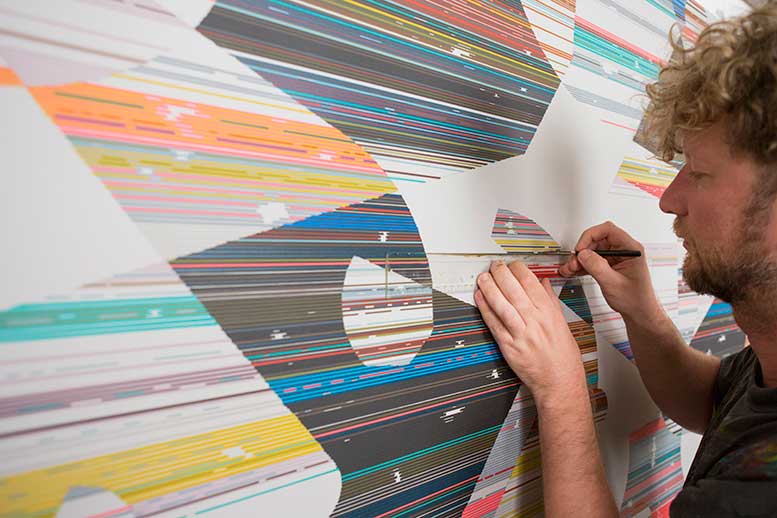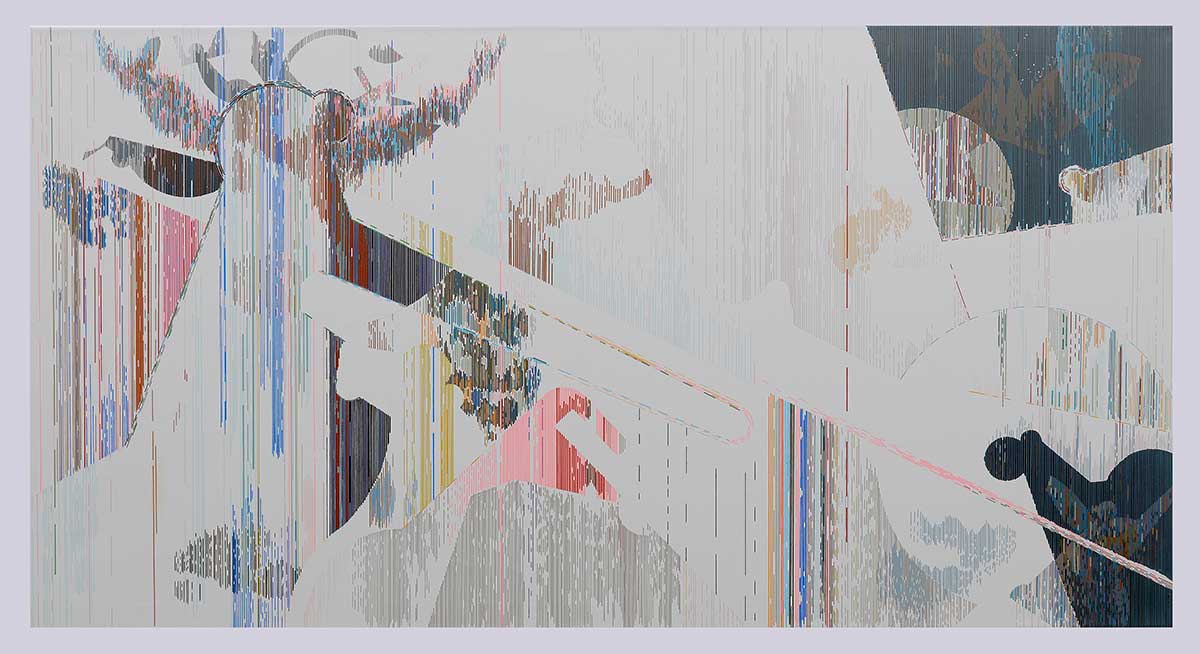Contemporary artist Jáno Vasilko shares his creative process in a free flowing essay about his inspirations and finding balance.

Studio shot. Artist in studio. Contemporary artist Jáno Vasilko.
The pursuit of geometry
Working notes form a part of my thinking and state of mind. However, they are not completely formulated into a comprehensive complex in the form of a book or doctoral thesis, but create a collage of important aspects for creation, as well as depict the process of thinking about art and its production.
Firstly, in recent years, I have been working with geometric painting strictly freely and without various binding rules or old-fashioned (traditional) procedures. Turning this system upside down a bit, or in other words, I turn it on my head. I connect the opposite poles, two incompatible approaches into one whole. Absolute freedom of composition and representation, which is close to rather abstract expressionism, combines in me or always mutates in some way together with a strict geometric system.
Origin of inspiration
If we imagine a classical example of a typical geometric painting, we can see the rigour, order, system, and almost mathematically calculated composition. Other essential features are also mechanicality and rationality and working with the concept. All these elements are justifyingly interesting and important for many great artists. But not for me personally. I want to work with geometric means of expression but in a different way, using a much more free system without rules. In such a process, it is possible to untie the artist’s hands, allow him to be free and not be bound by the given dogmas and laws of geometry. If I should express myself in one complete sentence – “For me, painting is an adventure of discovery and not slavish copying of drawn sketches, where nothing can be changed.”
Secondly, the image is the result of the act of creation. It’s a process, a story, one could say a performance (but the painter mostly paints without the audience). The thought in the artist’s head is an inspiration or an idea, which is only the beginning of the process of the work. The ending is the last line on the painting. The process of creation, from its beginning to its very end, is a kind of sacred (perhaps even shamanistic) ritual or celebration.
I know many artists who create using system 1. Idea 2. Sketch 3. Final sketch (study) and then completely machine copy the sketch on the canvas.

Contemporary art
This way, for me, is dull and monotonous. In the same way, it is not creation, but slavery. The longest time in such a case of painting is the enlarging of the sketch, which is mechanical work. The question, then, is whether the slavish and violent realisation of the very idea expressed in a sketch or in some conceptual text is no longer useless. Definitely not for me! All three main elements of creation, idea, sketch and the work itself are equal. Only by combining and equalising these processes can we avoid conceptual pressure and thus create a truly free art of abstraction.
Another important point is that if all three creation processes are not equivalent, we can have serial production and creation of artistic products in an industrial way. In this case, the artist himself no longer sees the work. Just make a sketch on your computer and other people will do it. Is this still art or just a mass production of decorative items for the living room?
Thirdly, “A line is a dot that went for a walk.” This is a famous fine arts methodology quotation. I myself have been working with geometric lines for a long time, and not only in this series. If I were to describe what I do or how I work with this basic and primary means of expression, I would probably say this, “I paint horizontal and vertical lines.”
This describes and characterises everything. However, in order to bring you closer to the problem, I need to break it down a little bit more.
Contemporary artist Jáno Vasilko on the steps of his creative process
To describe it further – I work with different lengths, however, the gaps are equally important as well. These lines can have the same or different colours. The intensity of inflation and minimisation, on the other hand, creates various sets, groups and structures. None of these words seems appropriate to me but it is necessary to name it somehow and these are the most characteristic words so far.
To take a personal attitude on the concept “line”, I need to get back to the very first sentence. I don’t see a line as a record of a certain point motion. The length is understood as strictly given abscissa. Something that is given and strict. An iron stick or a metallic pipe comes to my mind to materialize the solidity of the line. The metallic pipe delimits itself and it is a total antipole to the line that characterizes the idea of a runner or other fast-moving object.
If a disinterested viewer, who has never seen my paintings from this series before, would imagine my piece of work, a dot-and-dash code scheme will probably come to his mind. A lot of laymen, artists and critics told me that it is a coded text, dot-and-dash code or a record of certain techno or a house music song.

Elements of creation
It is not quite like that. I am not a magic prophet or a philosopher writing long and serious wisdom and bequests for future generations. It is not about music either. If I wanted to be a musician, I would become a DJ.
To be honest, the most important feature of my paintings is verticality and horizontality. Anytime I think about the idea of my painting I imagine Raffael Santis The School of Athens. Especially the gestures of two main figures of this scene – a realist Aristotle and an idealist Plato. One is pointing at the Earth, the other one is pointing upwards. For me personally, these are the most important things.
The most important thing is that I do not associate with none of those philosophers. There are many people who consciously or unconsciously avow to one or the other movement. For me, the most important thing is the harmony between the two characters. It is a balance that is most important. Excessive radicalisation in one direction or another is in a way a loss of equilibrium. Perfection is in balance. That’s what I’m talking about in these paintings.
Contemporary artist Jáno Vasilko on the creative brief
I combine strict and rational geometry with elements and procedures that are characteristic or close to expressionism or surrealism. I try to experiment between these seemingly unequivocal opposites within the fine arts.
Contemporary artist Jáno Vasilko.
Work with basic and primary elements of expression. My abstract paintings are not based on the abstraction of nature, lands of people or something else. My compositions are not even an encoded record, reference or concept. They are in a way subconscious improvisations and work with chance, close to psychic automatism. Paradoxically, they are strictly geometric and not traditionally expressive as we know them from surrealists or abstract expressionists. Here, combining strict and rational geometry with elements and procedures that are characteristic or close to expressionism or surrealism, try to experiment between these seemingly unequivocal opposites within the fine arts. For me personally, strict, rational, computable or even mathematical geometry is boring. The element of chance or previously obscure ending is much more exciting. The adventure of discovery and knowledge is more important to me than the schematic and tedious implementation of concepts.
– Contemporary artist Jáno Vasilko.
Before you go – you might like to browse our Artist Interviews. Interviews of artists and outliers on how to be an artist. Contemporary artists on the source of their creative inspiration.












Add Comment